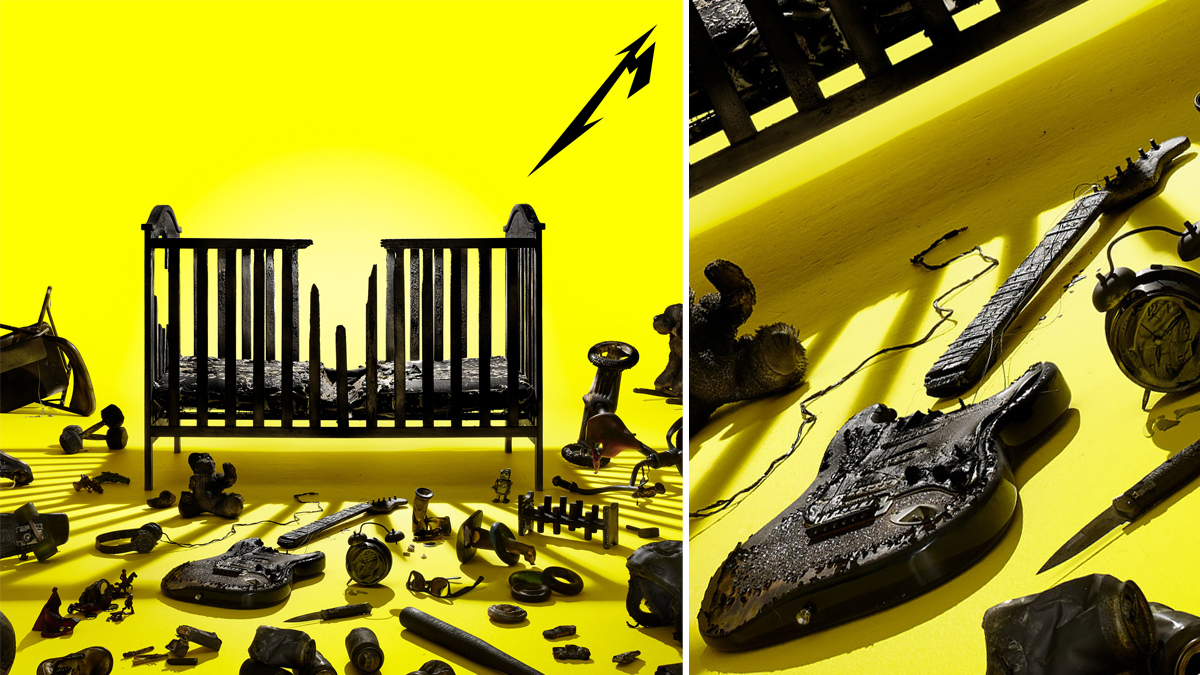What is that charred guitar on the cover of the new Metallica album?
We’ve got our theories – and they could add a whole new layer of meaning to 72 Seasons’ artwork

Yesterday (November 28), Metallica surprised the world with the unveiling of a new album, 72 Seasons, and its debut single, Lux Æterna.
The artwork for the metal titans’ new record depicts a broken crib and a number of charred possessions, reflecting its title – the 72 seasons, or first 18 years of our lives that form our selves, and the subsequent breaking free of that narrative. Cool concept, but one thing’s been bugging us: what the heck is the burned-up electric guitar on the cover?
Admittedly, there are very few clues. From what remains of the torched body, we can determine it’s a Strat-style guitar – but that’s no Fender headstock. In fact, the headstock is the only clue we have, and even that’s half in shadow from the crib above.
Yet from the limited evidence in front of us, we’ve determined the guitar could well be a late-’80s Fernandes LE-1 Strat copy – and as hardcore Metallica fans will know, that adds a whole new level of meaning to the album cover.
Founded in Japan in 1969, Fernandes was initially famed for its cheap replicas of Strat and Les Paul-style guitars, which offered guitarists cut-price versions of popular designs before the likes of Squier and Epiphone made it big with officially licensed budget Fender and Gibson instruments.
In the early-’80s, Kirk Hammett got his hands on a Fernandes FST-13, which was essentially a Strat copy with EMG single coils and a double-locking tremolo system – it was nicknamed ‘Edna’ and featured on the cover of The $5.98 E.P.: Garage Days Re-Revisited.
In fact, back when Metallica went to record Ride the Lightning, he owned just three guitars: a red Flying V with a white pickguard, a red Fernandes FST-65 and Edna.
Get The Pick Newsletter
All the latest guitar news, interviews, lessons, reviews, deals and more, direct to your inbox!
Early-’80s Fernandes models like Hammett’s had headstocks extremely close in shape to Fender instruments, but legal tussles saw the contours smooth out in the late-’80s to be closer to the instrument that may or may not grace 72 Seasons – see our comparison below.

And just to add further, ahem, fuel to this theory, Robert Trujillo was also a frequent Fernandes bass player in and out of Metallica – and, at one point, a fully fledged endorsee of the brand.
If that is indeed a Fernandes guitar on the album’s cover, it adds an extra level of meaning to 72 Seasons, paying homage to Kirk’s beloved and long since retired Edna, and Metallica’s early days in general.
It also makes us question how our early instruments can shape our playing experience further down the line, and even how our teenage listening and practicing habits can determine our musical approach for the rest of our lives.
Of course, we could be completely wrong on all counts – hell, it could just be a coincidence – but it’s a fun theory, right? Come on, Metallica, put us out of our misery…

Mike is Editor-in-Chief of GuitarWorld.com, in addition to being an offset fiend and recovering pedal addict. He has a master's degree in journalism from Cardiff University, and over a decade's experience writing and editing for guitar publications including MusicRadar, Total Guitar and Guitarist, as well as 20 years of recording and live experience in original and function bands. During his career, he has interviewed the likes of John Frusciante, Chris Cornell, Tom Morello, Matt Bellamy, Kirk Hammett, Jerry Cantrell, Joe Satriani, Tom DeLonge, Ed O'Brien, Polyphia, Tosin Abasi, Yvette Young and many more. In his free time, you'll find him making progressive instrumental rock under the nom de plume Maebe.









